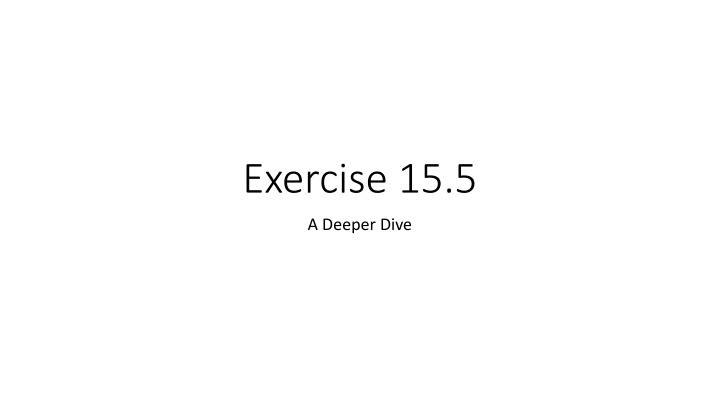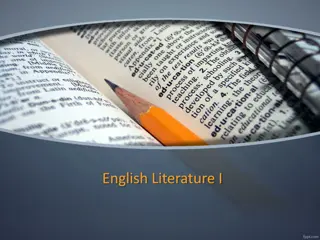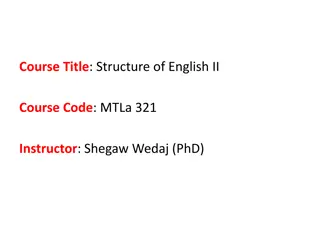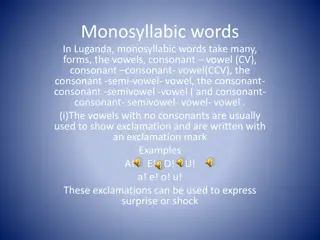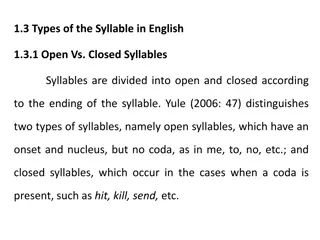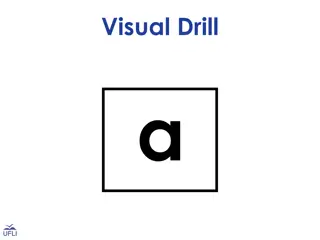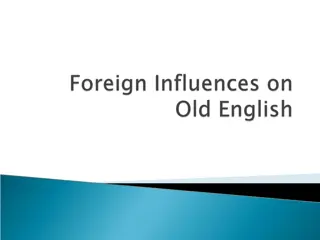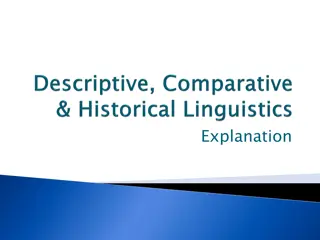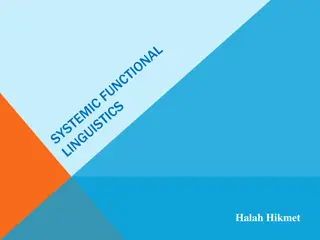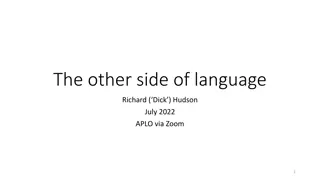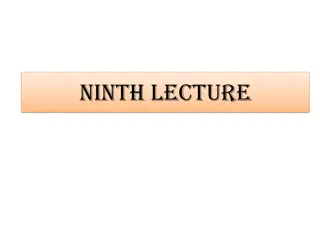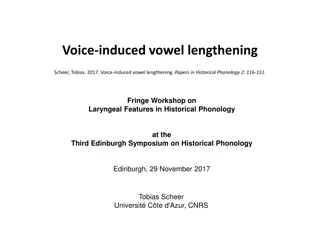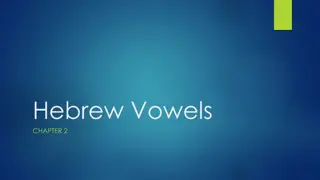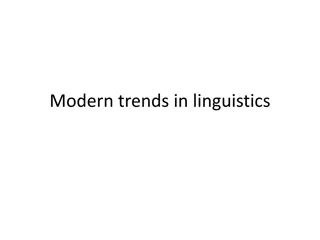Deciphering Vowel Evolution in Old English Linguistics
Unravel the intricate complexities of vowel evolution in Old English linguistics through a detailed examination of Proto-Germanic roots and phonological transformations. Explore the origins of words like 'leech' and 'land', tracing their linguistic journey from PIE to Old English. Delve deeper into the intriguing nuances of causals and consonant shifts to uncover the rich history embedded in linguistic evolution.
Download Presentation

Please find below an Image/Link to download the presentation.
The content on the website is provided AS IS for your information and personal use only. It may not be sold, licensed, or shared on other websites without obtaining consent from the author.If you encounter any issues during the download, it is possible that the publisher has removed the file from their server.
You are allowed to download the files provided on this website for personal or commercial use, subject to the condition that they are used lawfully. All files are the property of their respective owners.
The content on the website is provided AS IS for your information and personal use only. It may not be sold, licensed, or shared on other websites without obtaining consent from the author.
E N D
Presentation Transcript
Exercise 15.5 A Deeper Dive
First things first Vowels are harder than consonants We don t have all the information we would need to arrive at confident solutions The following is perhaps a bit of information overload: just take it one step at a time. As you work thru it, keep your finger in Fortson and a browser on Wiktionary and wikipedia and verify everything, so you really understand. Even if we can t be confident about every solution, that doesn t mean we can t learn and see what we can do. In fact, entirely the opposite: hard problems are great opportunities to learn and explore. So, let s see what we re dealing with
15.5a leech is from OE l e, which Wiktionary says is from Proto-Germanic *l kijaz. Cognate with Old Frisian l tza, Old Saxon l ki, Old High German l hhi, Old Norse *l kir (Danish l ge), Gothic ?????? (l keis) From Wikipedia PGmc Phonology article: all provable instances of inherited (PIE) * (PGmc. * ) are distributed in Gothic as and the other Germanic languages as * So it looks as if that long in *l kijaz is a long in a couple cognates (Old Saxon and OHG and ON) and a long in Gothic. Maybe it goes back to a PIE long * So Wikipedia says it is borrowed into OE from Oirish liaig and it seems to come from an original long . Oxford English Dictionary (OED) says *l kijaz comes from < PIE *l gio-s and Old Irish liaig is apparently related in some way. So the OED seems to confirm that the long is PIE and it looks like a long e grade of *leg-: SO WE HAVE AN ANSWER But the Wiktionary Index of PIE roots lists *leg- and *l gio-s as separate roots: https://en.wiktionary.org/wiki/Index:Proto-Indo- European/l Fortson tells us it comes from *leg- collect, gather (which is the same as is found later in logic and logos and legend ) So, in the end, we ve traced it as far as we can, we re pretty sure it s an e-grade originally, but we can t make the connection Fortson suggests between *leg- and l e That doesn t mean he s wrong: it means he s got a hypothesis he believes. Vowels are messy.
15.5b *lendh- land: OE land Grimm III explains that *dh > Gmc d The resonant *l stays the same from PIE to PGmc, says 15.13, and the OE section says nothing about changes to resonants. So only the vowel is left to explain. 15.14 says that *o and *a merged into PGmc *a, and 15.60 says that *a became fronted to ae in Old English except before nasals! (n is a nasal), so the *a stayed the same from PGmc to OE, and we re done!
15c*wes to put on clothes: OE werian (English wear ) The glide *w stays the same throughout. The *s changes to r: how/why? 15.8 tells us that Verner s law applied to *s, which became voiced PGmc *z But *wes- itself doesn t give us an environment for Verner s law, which applies to consonants not after a stressed syllable. Wiktionary to the rescue: they say that wear < OE werian < PIE *wos yeti, from *wes- In other words, this is a causal verb from *wes- and if you remember the causals in 5.35, they are formed on the o-grade of the root plus a stressed suffix *- ye- Note that the *s in *wos yeti is not after the stressed syllable, and so Verner s law applies and it changes to PGmc *z 15.50 tells us that *z was rhotacized to r in West Gmc, which includes OE So far, so good, but what about the vowel? Next page
The vowel in werian Fortson says that for the purposes of this exercise, any Gmc *e would go to i (15.15 says the same) so PIE *e is not where the e in werian came from. Colton tells me that that leaves the PIE *o > *a > e when followed by j or I change as the only way to get a short e in OE A little digging on Wikipedia Germanic Umlaut finds the following, which confirms Colton s astute observation: The phonologically expected umlaut of /a/ is / /. However, in many cases /e/ appears. Most /a/ in Old English stem from earlier / / because of a change called a-restoration. This change was blocked when /i/ or /j/ followed, leaving / /, which subsequently mutated to /e/. For example, in the case of talu "tale" vs. tellan "to tell", the forms at one point in the early history of Old English were *t lu and *t lljan, respectively. A- restoration converted *t lu to talu, but left *t lljan alone, and it subsequently evolved to tellan by i- mutation. The same process "should" have led to *bec instead of b c . That is, the early forms were *b can and *b ci . A-restoration converted *b can to bacan but left alone *b ci , which would normally have evolved by umlaut to *bec . In this case, however, once a-restoration took effect, *b ci was modified to *baci by analogy with bacan, and then later umlauted to b c . So the key here was to observer that i in werian as part of the environment. Remember that for 15.5f
15.5d *dhreibh- drive, push: OE drift Wiktionary gives us a bit more detail: *dhreibh- > PGmc *driftiz > OE drift Grimm III gives us the first consonant: PIE *dh > PGmc *d as the first consonant Second phoneme, resonant *r, stays the same. The vowel: *ei is a diphthong in PIE, but Fortson doesn t cover that diphthong in this chapter. Wiktionary, however, in Proto-Germanic Language says: Note the change /e/ > /i/ before /i/ or /j/ in the same or following syllable. This removed /ei/ (which became /i /) but created /iu/ from earlier /eu/. Is that what we re dealing with? The stage PGmc*driftiz suggests that it is, because it fits: there s an /i/ in the following syllable. So that suggests that the change from PIE *ei to PGmc *i was a regular change. And that s the answer to this exercise: it s from an e-grade root. Because I m curious, let s figure out the rest: just skip this if you don t have time. Wiktionary PGmc *driftiz gives us From *dr ban + *- iz. So we re dealing with a verb plus a suffix The verb base: *dr ban : this is the root of English drive and gives us a voiced labial b: see below for why this changes to f. The suffix is from PIE *-tis, which is used to form nouns from verbal roots (Fortson 6.42: it s the same as sis in analysis and basis and many other words. Grimm I changes PIE *-tis to PGmc *- iz. 15.50 tells us the final *z drops out by the time we get to Old English drift The *b-tis > OE ft 15.7 tells us that only the first of two voiceless stops undergoes change, but that applies to voiceless stops, whereas here we have a voiced b + voiceless t. On the other hand, we find a parallel in daft , from *daftuz ( appropriate, apt, convenient, suitable; decent; accommodating, agreeable ), ultimately from Proto-Indo-European *d h eb - And another parallel in swift, from Proto-Germanic *sw ban , so even if we can t find this piece explicitly in Fortson, we can have a good stab at it.
5.15e *re- to direct: OE riht right (modern English right Wiktionary is a treasure-trove on right : from Proto-Germanic *rehtaz ( right, direct ), from Proto-Indo-European *h re t s ( having moved in a straight line ), from Proto-Indo-European *h re - ( to straighten, direct ). An Indo-European past participle, it became a Germanic adjective which has been used also as a noun since the common Germanic period. Clearly the word-initial laryngeal h dropped out, as 15.12 confirms. 15.15 tells us that PIE *e tended to change to PGmc *i, which agrees with the Wiktionary analysis. And we re done: it s from an e-grade of *h re - / *re - (Fortson probably left off the laryngeal just because it disappeared without a trace in Gmc).
15.5.f *re- to direct: OE gerecenian arrange The hint that pre-OE (which is also known as PGmc) would have been *gerecinian is important because it tells us that there was an *i in that 3rd syllable. But the reasoning is a bit circular: he reason for an i is at least partly to explain the change we are trying to explain. Go back a few slides to the one about the vowel in werian. The same reasoning applies here, since we know that the path is PGmc *gerecinian > OE gerecenian, which means that it was an o-stem ge-roc-inian. BTW, the ge- prefix so common in OE seems to me often to mean nothing at all and to be added or not added to OE verbs often for no particular reason: Wiktionary confirms that: it explains that ge- Forms perfective verbs from other verbs with a sense of completeness, or simply as an intensifier.
15.5g *dhers- dare: OE 3rdsg. durst This one is a puzzler, and Colton and I can t solve it with confidence. Wiktionary and OED (Oxf. Engl. Dictionary) call it a preterite-present (15.32) which means that its present forms are identical to those of a strong verb s preterite forms. Both sources give the full conjugation. Although there is evidence for other forms provided by the OED (more on that in a sec), I also find that it is said in Old English to have belonged originally to the third ablaut series ders- , dars- , durs- and also it is said that The original 3rd singular present he dare, and past tense durst, remained undisturbed to the modern period. So durst looks like it might be 3rdsg. past tense. 15.25 says that the preterite (past tense) was generally formed from the PIE perfect (which would be *dhedhors-), but without reduplication. So that makes it *dhors-, which after Grimm III turns into PGmc *dors-, which fits the reported form in the OED (which says the form is durst, but reports actual quotations only as dorste: not sure what to make of that). All of that is enough to make a very good educated guess that it was an o grade ablaut.
15.5h *rewdh- to clear land: OE rodd stick Now that s a rather big shift in meaning. This etymology is not accepted as certain by everyone (the OED, for example, does not endorse it). In the instructions, Fortson tells us that Gmc. *-u- > OE o-, and at 15.61 that *eu > eo (long e short o). So we could say that rodd comes from the e-grade *rewdh- Why, however, couldn t it come from *rowdh-, the o-grade? Not sure. Grimm III gives us *dh > PGmc d, but what happens to the vowel eo and why are there two d s as the final consonants instead of one? I don t have an answer, but I m curious.
15.5i *nem- to take: OE numen seized From Wiktionary: OE niman < proto-Germanic *nemana < PIE *n m-e-ti (thematic root present) Fortson, at 15.13, says that syllabic resonants developed a u- in front of them and gives this very OE past participle as an example: *nm(m)-ono- taken > Gmc. *numana- > OE numen > English numb (the b is added analogically to words like thumb, I think). Once you find that at 15.13, it s clear what Fortson thinks the answer is: numen is from a zero-grade *nm(m)-ono- SO that s that, but Colton points out that Fortson s answer seems to rely on Lindeman s/Edgerton s extension of Siever s law, but that extension is not supported by very many experts and seems to be rejected by the most recent ones. An alternative is that the reconstructed typical pattern of a Gmc past participle with a u- in the root kept the u in this case. Apparently niman is classified as a class 4 OE verb (from OED and Wiktionary, I think) In class 3 and the past participle of class 4, there were PIE syllabic resonants which developed in Germanic to u plus resonant; thus u became the Germanic sign of these parts. I m not sure whether that s a remnant of Lindeman/Edgerton and is now considered obsolete, but it does look like a good answer here. Basically, for our purposes, we ve got Fortson s answer, but we also have a healthy reminder that this field still has many areas where experts disagree. That s not bad, just confusing to newbies. (and kind of exciting?)
